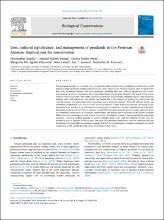Por favor, use este identificador para citar o enlazar este ítem:
https://hdl.handle.net/20.500.12921/390| Título : | Uses, cultural significance, and management of peatlands in the Peruvian Amazon: Implications for conservation |
| Autor : | Schulz, Christopher Martín Brañas, Manuel Núñez Pérez, Cecilia Del Águila Villacorta, Margarita Laurie, Nina Lawson, Ian T. Roucoux, Katherine H. |
| Palabras clave : | Conocimiento indígena Conocimiento ecológico Urarina, pueblo indígena Turberas Valores culturales Pueblos indígenas Chambira, río |
| Fecha de publicación : | jul-2019 |
| Editorial : | Elsevier |
| Citación : | Biological Conservation, 235:189-198 Schulz, C., Brañas, M. M., Pérez, C. N., Villacorta, M. D. A., Laurie, N., Lawson, I. T., & Roucoux, K. H. (2019). Uses, cultural significance, and management of peatlands in the Peruvian Amazon: Implications for conservation. Biological Conservation, 235, 189-198. |
| Resumen : | Tropical peatlands play an important role in the global carbon cycle by acting as significant carbon stores. South America's largest peatland complex is located in the Loreto Region of the Peruvian Amazon. Here we present the first study of human relations with these peatlands, including their uses, cultural significance and current management, as well as implications for conservation, based on qualitative research with people living in two riverine rural communities. Our results indicate that peatlands are culturally ambiguous spaces, used mainly for hunting, palm fruit harvesting, and timber, but feared due to the dangers of getting lost, sinking into the ‘sucking’ ground, and being attacked by anacondas and/or mythical creatures. While the difficult terrain and remoteness of peatlands have thus far acted as natural barriers to their destruction through conversion to different land uses, overuse of natural resources is nevertheless a significant concern for people living in the peatdominated landscape of the Peruvian Amazon, mixed with frustration about the lack of outside support to foster environmental conservation and economic opportunities. We explore how evaluations of the present situation differ across one indigenous and one mestizo community. We identify a range of nascent peatland conservation strategies, including seedling planting to regrow valuable (palm) trees, and the climbing of palm trees for harvesting fruit as opposed to felling them. We argue that peatland conservation could be combined with the development of sustainable management strategies, but that this would require sustained engagement by outside organisations with rapidly growing local communities in these areas. |
| URI : | https://doi.org/10.1016/j.biocon.2019.04.005 https://hdl.handle.net/20.500.12921/390 |
| ISSN : | 0006-3207 |
| Aparece en las colecciones: | Artículos en revistas indexadas |
Ficheros en este ítem:
| Fichero | Descripción | Tamaño | Formato | |
|---|---|---|---|---|
| Schulz_articulo_2019.pdf Until 2039-12-01 | Texto Completo | 909,44 kB | Adobe PDF |  Visualizar/Abrir Request a copy |
Compartir :
Los ítems de DSpace están protegidos por copyright, con todos los derechos reservados, a menos que se indique lo contrario.



